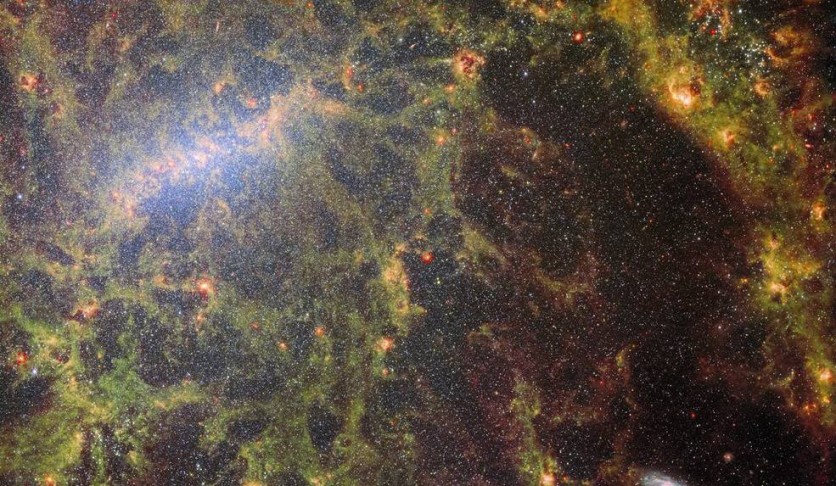The captivating beauty of the universe unveils itself once again as the James Webb Space Telescope captures a mesmerizing image of the barred spiral galaxy NGC 5068.
In this celestial snapshot, delicate threads of dust and dazzling star clusters weave an intricate tapestry across the cosmic canvas.
Revealing this stunning image during an event at the Copernicus Science Centre in Warsaw, Poland, NASA Administrator Bill Nelson shared the awe-inspiring marvels of the universe with enthusiastic students.

Astronomical Treasure Trove
NGC 5068, residing approximately 20 million light-years away in the Virgo constellation, takes center stage in this composite image generated from two of the James Webb Space Telescope's cutting-edge instruments.
This remarkable photograph contributes to a comprehensive campaign aimed at creating an astronomical treasure trove, a repository of invaluable observations illuminating the star formation process in nearby galaxies.
Previous jewels from this collection have already enthralled astronomers with breathtaking images of IC 5332 and M74.
The significance of these observations extends far beyond their sheer beauty. Star formation serves as the backbone of numerous astronomical fields, encompassing everything from the intricate physics of interstellar plasma to the evolution of entire galaxies.
By closely studying the formation of stars in nearby galaxies, astronomers anticipate significant scientific breakthroughs, propelled by the initial data captured by the James Webb Space Telescope.
These observations also build upon previous studies conducted by renowned telescopes such as the Hubble Space Telescope and ground-based observatories.
Webb's remarkable images of 19 nearby star-forming galaxies seamlessly intertwine with Hubble's visual records of 10,000-star clusters, spectroscopic mapping of 20,000 star-forming emission nebulae from the Very Large Telescope (VLT), and meticulous observations of 12,000 dark, dense molecular clouds identified by the Atacama Large Millimeter/submillimeter Array (ALMA).
This comprehensive approach, spanning the electromagnetic spectrum, offers astronomers an opportunity to unlock the intricacies of star formation.
Read Also : NASA's Webb Spots Massive Plume from Saturn Moon Spanning Nearly the Distance from LA to Buenos Aires
Piercing Vision
The unparalleled capabilities of the James Webb Space Telescope, with its ability to pierce through the obscuring shroud of gas and dust enveloping nascent stars, make it an indispensable tool for investigating the mechanisms governing the birth of celestial objects.
While visible-light observatories like Hubble or the VLT are hindered by the opaqueness of swirling clouds of gas and dust, the infrared vision of the telescope's MIRI (Mid-Infrared Instrument) and NIRCam (Near-Infrared Camera) instruments transcends these barriers.
It allows astronomers to witness the mesmerizing dance of star formation within NGC 5068, capturing the intricacies of the process in realtime.
This extraordinary image, combining the unique capabilities of the telescope's instruments, offers an unparalleled glimpse into the composition of NGC 5068, unraveling the mysteries of this cosmic masterpiece.
As the James Webb Space Telescope continues to explore the depths of our universe, it promises to unveil countless more celestial wonders, expanding our understanding of the cosmos and inspiring generations to reach for the stars.
Related Article : NASA's James Webb Space Telescope Catches an 'Asteroid Photobomber' Roughly the Size of Rome's Colosseum





